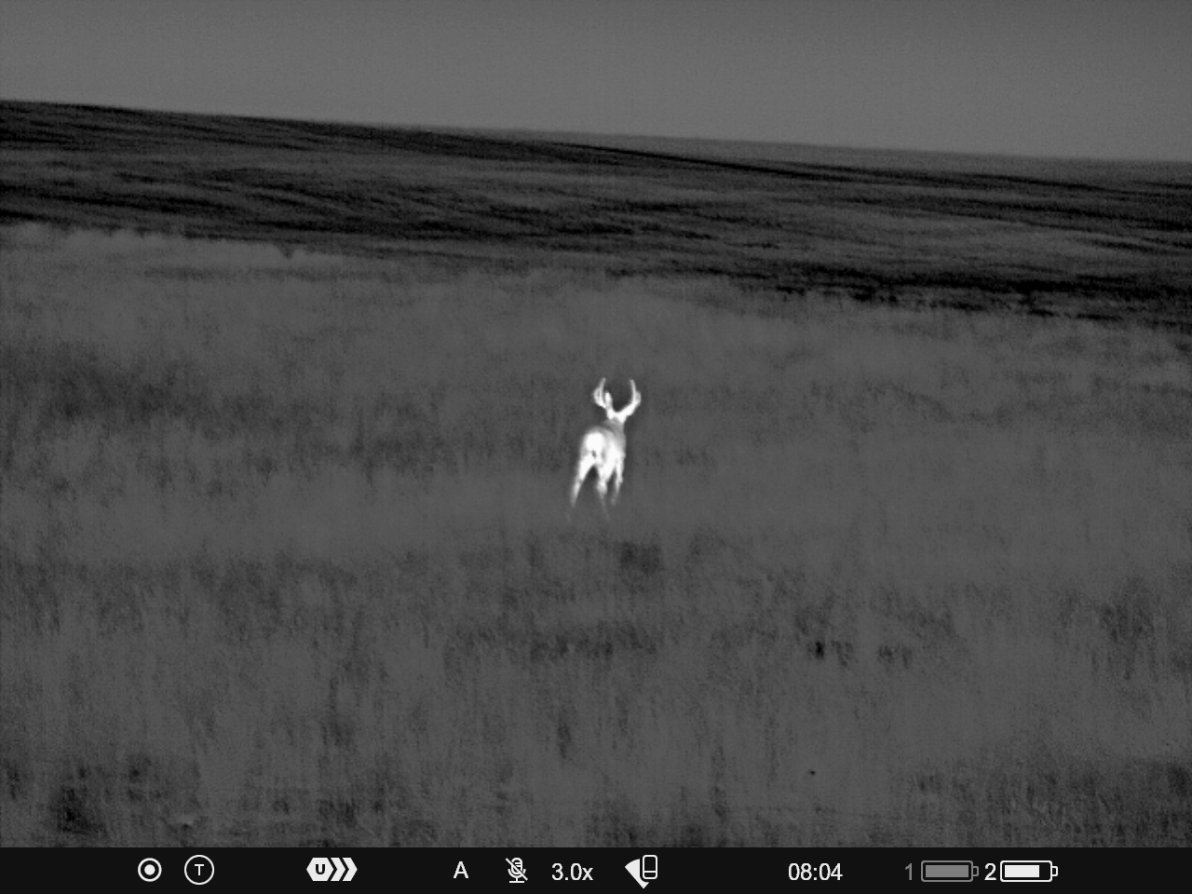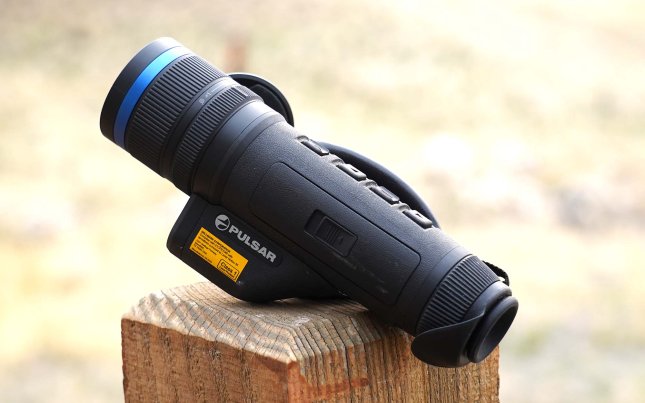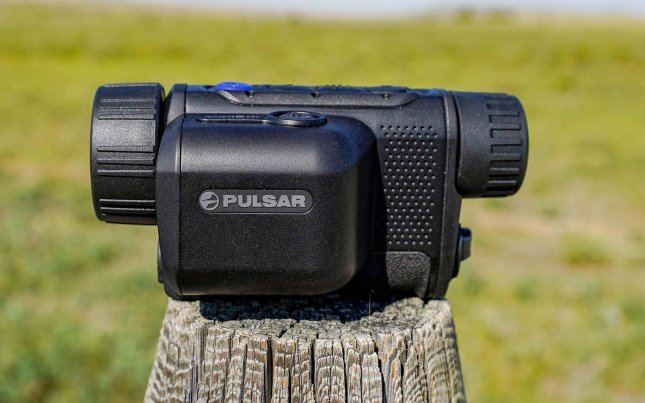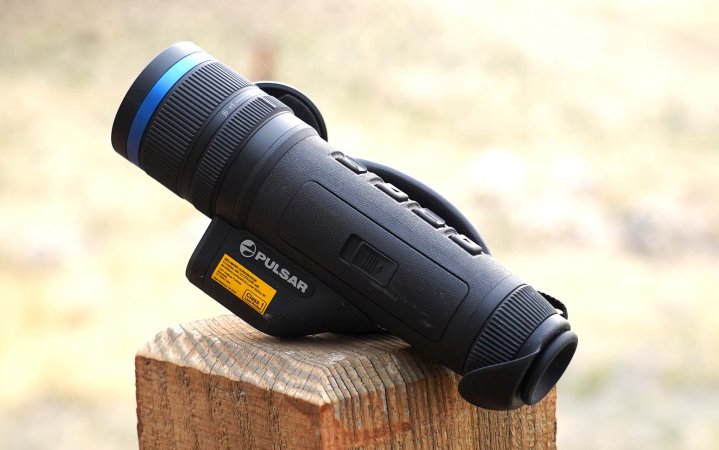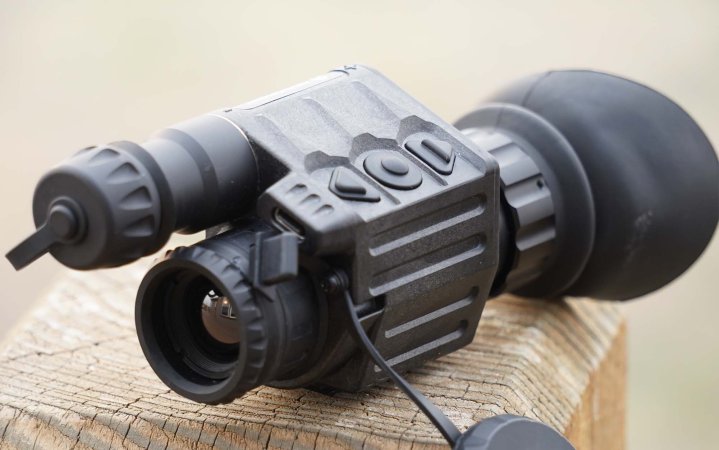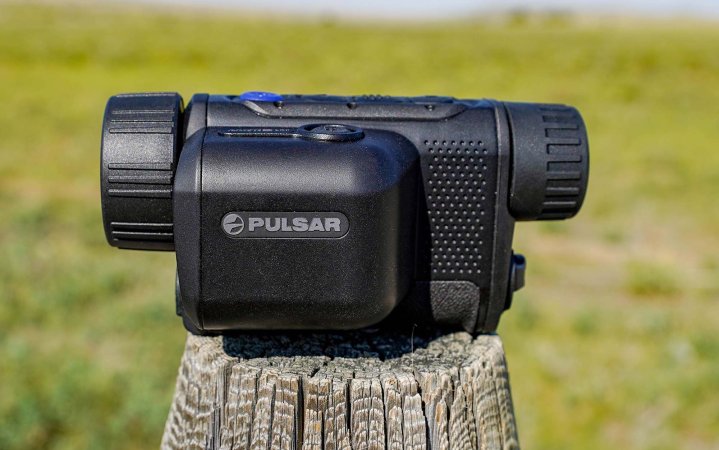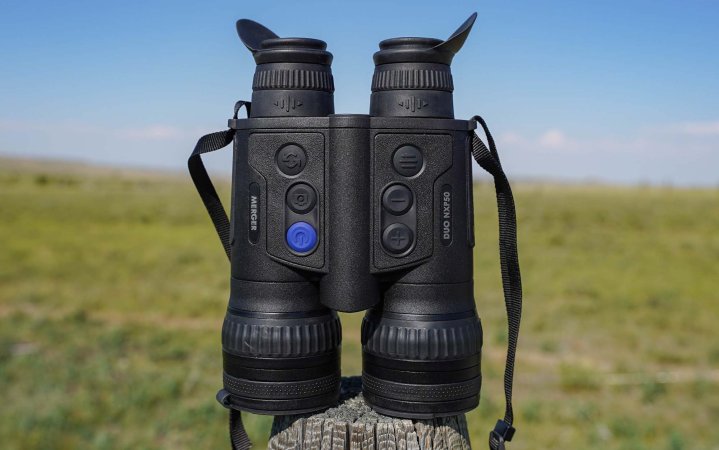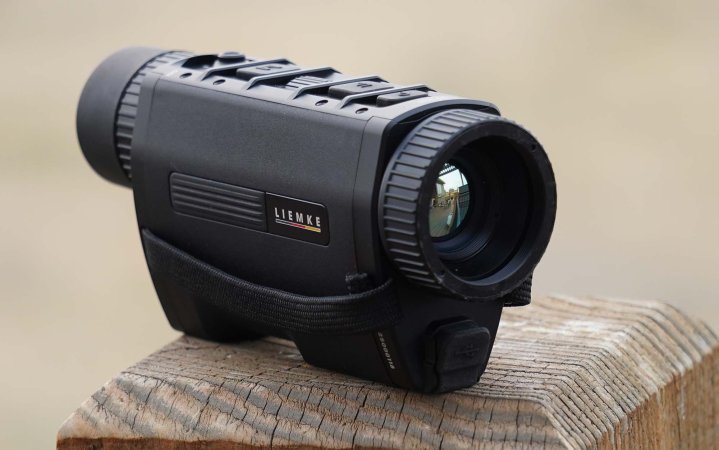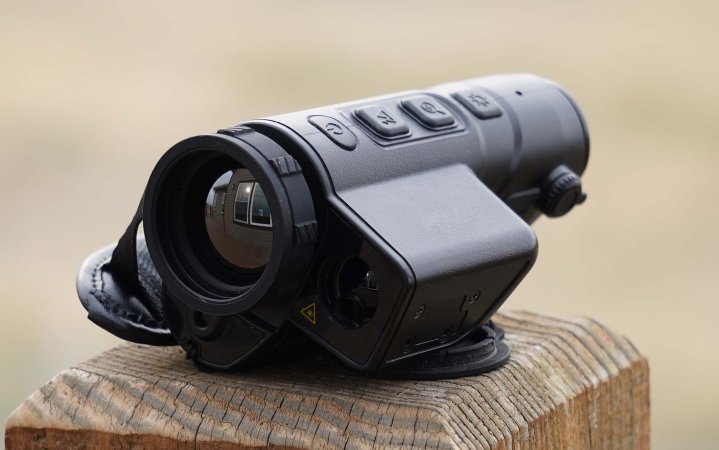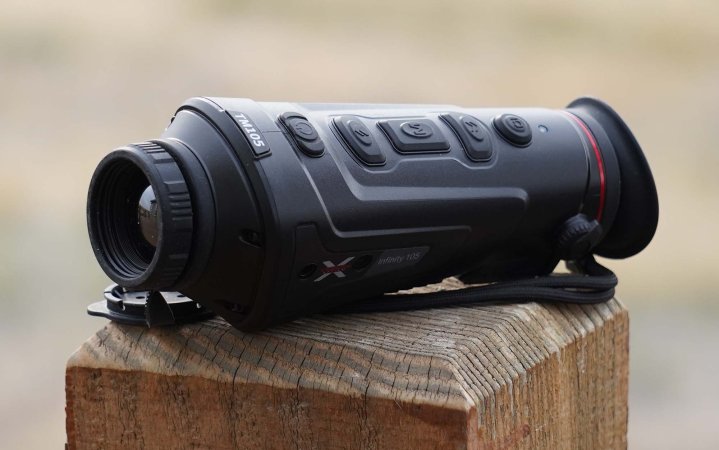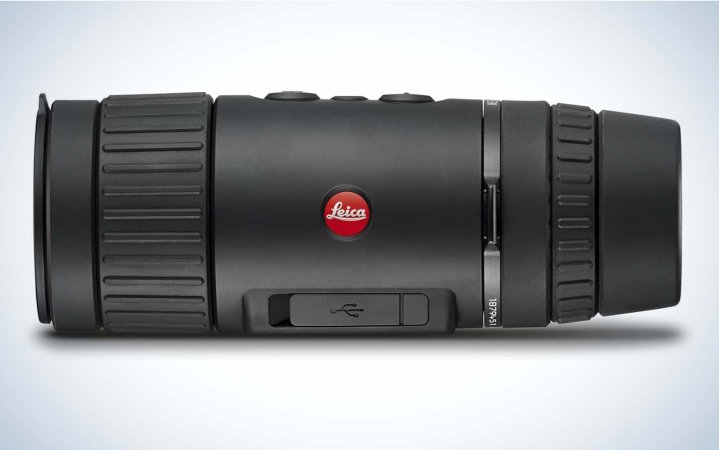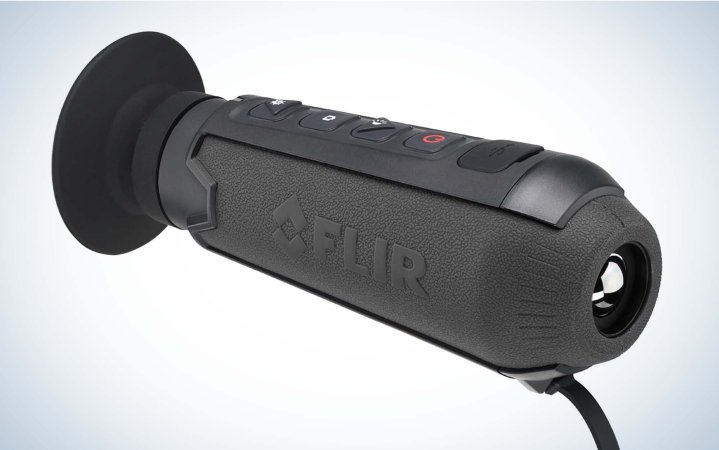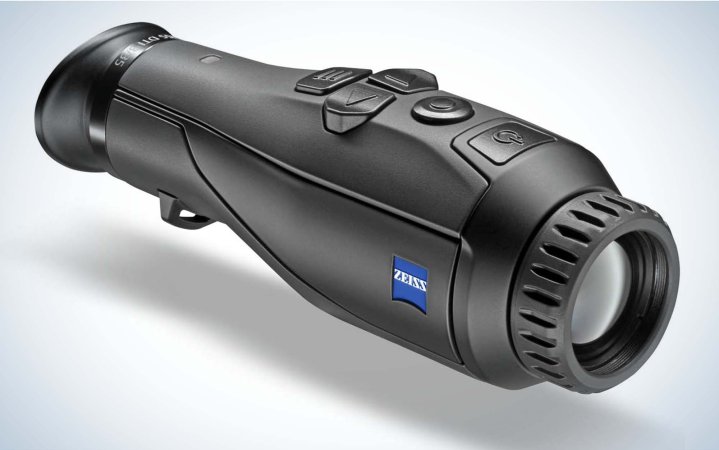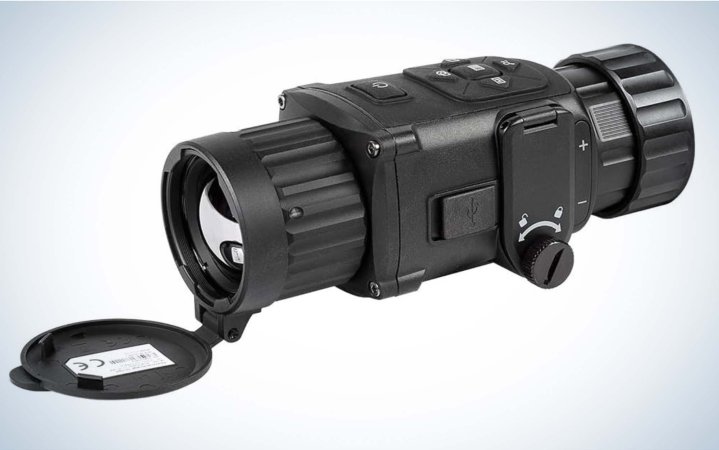We may earn revenue from the products available on this page and participate in affiliate programs. Learn More ›
While every serious thermal hunter is going to want a dedicated heat-detecting rifle scope, I’d make the case that thermal monoculars and binoculars are more versatile than weapon-mounted sights.
The full utility of a viewer is demonstrated when combined with a rifle scope. One of the dirty little secrets of thermal hunting is that you actually need two optics — a viewer and a scope — to get the most out of the platform. When hunting with a buddy, one of you should be scanning the landscape with the monocular while the second stays behind the thermal scope in order to put a shot on the target the scanner has detected and identified.
But while a dedicated thermal scope is sort of useless without a companion viewer, a hand-held monocular or binocular is quite useful even if you don’t have a thermal scope at hand. Thermal viewers have wide application as a game-finder, a retrieval device for wounded game, as a search-and-rescue tool, as a backcountry companion to detect bears or other potential nocturnal hazards, and a cool observation tool. I’ve even used my thermal viewers to detect problematic electrical transformers, junction boxes, and circuitry in the walls of my house.
Here are the findings of extensive testing of eight of the best thermal monoculars. We pulled these out at our 2024 Outdoor Life Optics Test and continued to field-test them through the summer and fall. They have miles of prairie and hours of run-time under their belts.
- Editor’s Choice: Pulsar Telos LRF XL50
- Innovation Award: Armasight Sidekick 640
- Great Buy: Pulsar Axion 2 XQ35 Pro LRF
- Best Thermal/Night-Vision Hybrid: Pulsar Merger Duo NXP50
- Best European-Made Monocular: Liemke Keiler 25.1
- Newcomer Award: Athlon Cronus ATS 35ML-400
- Best Thermal Binocular: X-Vision Beyond 300
- Best Entry-Level: X-Vision Infinity TM105
How I Tested the Best Thermal Monoculars

This field includes a number of thermal monoculars and binoculars that were introduced in 2024 and submitted to Outdoor Life’s optics test. The remainder are units that have been on the market for a few years but are still worth your consideration, either because they are standards of the category, because they’re good bargains, or simply because they occupy an important niche in the category.
The eight units submitted for the Optics Test have been subjected to the most intensive testing we’ve devoted to thermals. I’ve spent hours over several months in the field with them and have loaned them out to friends who have taken them coyote and rabbit hunting over the course of several weeks.
Testers evaluated basic functionality, from using various modes and color palettes to measuring battery life. We also tried to collect a variety of images and videos and then assessed how easily we could transfer content from the units to our phones through either mobile apps or cable connections. We also assessed the relative resolution and image quality of each unit.
Because we took units out in varying conditions it’s hard to measure head-to-head performance. Instead, our conclusions are more anecdotal than comparative. But they include hundreds of total hours of mainly nighttime testing, using these hand-held thermals in a variety of conditions and outings.
Best Thermal Monoculars: Reviews & Recommendations
Editor’s Choice: Pulsar Telos LRF XL50
Key Features
- 2,300-yard detection range of deer-sized target
- 1,000-yard laser rangefinder
- 2.5-20x magnification
- Photo and video recording and WiFi image transmission
- 1024×768 @12-micron sensor resolution
- 1024×768-pixel display resolution
This flashlight-sized thermal is easy to use, renders excellent images, is built double-tough, and stands out as one of the first of the industry’s high-definition thermals. With a 1024×768-micron sensor, it’s one of the most advanced thermals on the market, and thanks to a fast operating system and one of the best mobile apps in the business, it’s a cinch to operate the thermal from your phone and to store and share both videos and still images.
The unit’s three-button operation is fast and intuitive, flattening the learning curve and making nighttime operation easy, even for hunters who haven’t gotten used to navigating a thermal based on feel and memory.

After handling dozens of thermals in the course of our testing, I can say that most feel flimsy and made mainly of fragile plastic. The Telos is constructed out of rubber-armored reinforced plastic, so unlike a magnesium-frame binocular or aluminum-tube riflescope, it will break if abused, but it has a solid-state feel, and its internal operation is equally robust and positive.
It’s a thinly concealed trade secret that some thermal devices attempt to amplify low sensor resolution with relatively higher display resolution. Imagine an image the size of a postage stamp. The only way to increase its size is to magnify the already tiny image, but when you increase an indistinct image, you only magnify its deficiencies. That’s essentially what happens when display resolution exceeds sensor resolution in most thermals; the high-def displays simply make fuzzy images larger. The Pulsar Telos, with a display resolution the same size as its sensor resolution, delivers sharper, more robust images than its peers as a function of its more advanced technology.
But there’s a price for that performance. This thermal monocular costs over $5,000, putting it out of reach of many hunters. While we’re covering its shortcomings, we should note that the manual zoom — users twist a knurled ring just inside the objective focus ring — is easy to use, but it’s so tight that as users zoom up or down in magnification, it’s hard to keep the image centered. I’d like to see a tripod mount on the unit; it would be a way to stabilize the image and add to its prodigious utility.
Lastly, the laser rangefinder is a key feature, but you have to riff through a number of menu items to simply activate the stadiametric rangefinder. It’s tedious and time-consuming when precious minutes count.
Merits include the excellent StreamVision 2 app that connects all Pulsar units with mobile phones. The interface is clear and easy to use, and users can easily use their phones as device displays, activating cameras, switching palettes, and boosting image sensitivity. Unlike many thermal units, which have only 2.4-GHz Wi-Fi transmission, the Pulsar adds a 5-GHz bandwidth to broaden the connection between unit and phone and make image transfer and wireless communications even more frictionless. The device stores a healthy 64 GB of memory on-board, and the app easily transfers images from the thermal to a mobile device when you’re back from the field.
Of all the thermal viewers that we tested, this is the one that we reached for after our evaluations, when it was time to simply enjoy the talents of a thermal without fuss or frustration. If cost is no option, then this is hands-down the unit for you – and for us. And if you’re a budget shopper, consider that this overbuilt, super-resolution thermal is where most of its peers will be two and three years from now.
Innovation Award: Armasight Sidekick 640
Key Features
- Effective Ranges on Human-Sized Target: 709-meter detection, 177-meter recognition, 111-meter identification range
- 1-4-times digital zoom
- 4-hour on-board video storage
- Helmet-mountable
- 640×480 12-micron sensor resolution
- 1024×768-pixel display resolution
The smallest full-featured 640-class thermal monocular on the market, this little powerhouse goes anywhere, and can be used as either a hand-held or helmet-mounted device.
The Sidekick weighs just over half a pound, but its image and sensitivity matches that of monoculars three times its heft and ten times its dimensions. Its diminutive size does have some drawbacks, including relatively short battery life, no Wi-Fi connectivity to an app, and limited detection range.

The full value proposition of the little Sidekick 640 is demonstrated when mounted to a helmet. The idea is that a solo hog or coyote hunter can run the Sidekick as a monocular on their weak side, picking up incoming animals with its wide field of view and very good display resolution. The hunter can then get behind a thermal-mounted rifle to complete the shot. That sort of transitional deployment is hard to achieve with most hand-held monoculars.
The small size and integration with night vision and other helmet-mounted devices hint at the origins and intention of the Armasight: It’s really a military-grade thermal. That doesn’t mean it doesn’t have abundant civilian application, it’s just that you’ll get the best out of the unit if you run it in tandem with other operator-centric devices.
The guts of the Sidekick are the thermal core, standard sensor, and high-resolution displays you’ll find in most of the thermal devices in our test. We’d like to see a Wi-Fi or Bluetooth transmitter on board, in order to wirelessly transfer images and videos from the unit to a phone and to enable remote operation. But the three-button navigation is simple to use, and the tactile feel of each button enables smooth, fast operation, even when the Sidekick is mounted on a helmet. If you run this unit in cold weather, or for long hunting sessions, you’ll want to bring extra CR123 batteries or use the Armasight battery extender. The run time of the standard batteries is a little over an hour.
This isn’t the thermal for everyone, but for those who hunt by themselves and who are comfortable with a head-mounted viewer, it’s a military-grade unit that’s fully at home in the coyote hills and hog fields.
Great Buy: Pulsar Axion 2 XQ35 Pro LRF
Key Features
- 1,300-meter detection range
- 1,000-meter laser rangefinder
- 2-8x magnification
- Photo and video recording and WiFi image transmission
- 8 color palettes
- 384×288 sensor resolution
- 640×400-pixel display resolution
If you are driven to fist-clenching rage by Pulsar’s cutsie and confusing nomenclature, in which similar-looking thermals share nearly identical names, but have wildly different operating features and prices, then join me in complaining to the company. Or to the heavens, at least. Case in point is this very capable, very appealingly priced hand-held thermal monocular, the Axion 2 XQ35 Pro LRF. It costs about $1,800, one of the more price-accessible thermals on the market, priced low mainly because it has a small and fuzzy sensor.
The nearly identical Axion 2 XG35 LRF costs almost twice as much, right at $3,000. It looks and operates nearly the same as the XQ35, but it has a high-resolution sensor that provides about three times the resolution. Hence, the heftier price.

But a casual shopper sees mainly the price differential and the nearly identical name, not the delta in performance.
We’ll talk about those performance shortcomings in a bit, but first I want to make the case that the XQ35 is a very good choice for a first thermal for a casual hunter. First, it shares a robust and field-worthy chassis with the XG35. Both are built on magnesium alloy, a rarity in the plasticky world of thermals. Second, the 35mm objective lens they share is sized about right for most purposes. Internally, the Pulsars share an operating system and rechargeable battery type. And both communicate through Pulsar’s very good StreamVision 2 app, which capably operates the unit remotely and accepts wirelessly transmitted videos and photos. Lastly, the laser rangefinder is the same in both units, and actually not very accurate.
The biggest difference between the two — apparently a $1,200 difference — is the thermal sensor. The more expensive XG35 has a 640×480-pixel sensor with 12-micron pitch. The budget XQ35 has a 384×288-pixel sensor with 17-micron pitch. The 640-class sensor is the industry standard; the 384 sensor means that images from the cheaper Pulsar will be fuzzier.
The differential in resolution is further exaggerated by the fineness of the displays. The XQ35 has a 640×400-pixel display, while the XG35 has a high-def 1024×768 screen.
Is that level of sensitivity and resolution worth $1,200 to you? Only you can answer that question, but the difference is observable in image capture. Photos and video from the XQ35 will be grainier and less capable of being enlarged than the relatively more detailed and crisper images from the XG35.
If you are simply using your thermal viewer to detect targets at night, you probably won’t notice much difference. But if you are the sort of thermal user who wants to capture and share videos from your outings, you might want to opt for the higher-resolution monocular.
Bottom-line: If you have the funds to spring for the more expensive Axion 2 XG35 LRF, do it. No one in the history of cameras or optics has regretted having more resolution. But if you can only afford the Axion 2 XQ35 LRF, get to learn its operating features and its capabilities, and then apply your knowledge to buying a more sophisticated thermal down the road, as these units become more affordable, and as your own disposable income increases.
Best Thermal/Night-Vision Hybrid: Pulsar Merger Duo NXP50
Key Features
- 1,969-yard detection range
- 1,100-yard stadiametric rangefinder
- 3-24x magnification
- Photo and video recording and WiFi image transmission
- Tripod-mountable
- 640×480- microbolometer sensor resolution
- 1280×960-pixel display resolution
At just over $6,000, the Pulsar Merger Duo is nearly the priciest thermal viewer in our collection. It’s certainly the most versatile.
The Duo in its name implies its dual thermal-night-vision capability. Simply press a button and the Pulsar switches from standard thermal viewer to night-vision optic. The dual function enables the unit to detect heat signatures in complete darkness (the thermal side of the house) or to amplify ambient light to highlight visible objects (that’s the night-vision side). An auxiliary LED illuminator, housed in the belly of the binocular, provides additional light for night-vision visibility.

The Merger Duo is like other thermal binoculars in that it’s not actually a binocular. Sure, it has two barrels, but only one has the heat-detecting element germanium in its objective lens. The other lens is for observation only, but also provides binocular vision for the night-vision function.
The heart of the Pulsar is its 640×480 microbolometer sensor that is enhanced by a high-def 1280×960-pixel display. This is the same imaging engine found in the XG35 monocular that we discussed in the review of Pulsar’s Axion 2 XQ35 Pro LRF monocular. The functionality of the Merger Duo is identical to the higher-end monocular. Both are supported by the excellent Stream Vision 2 app that allows user to store and share video and images captured by the devices and also operate some functionality like changing color palettes and even firing the device’s camera.
Like the monocular, the Merger Duo binocular features a laser rangefinder. Unlike the monocular, where the rangefinder is essentially bolted on the chassis, the rangefinder is built in to the binocular’s substantial chassis. It’s what’s called a stadiametric rangefinder, which uses a bracketing line to provide approximate distance to objects of a known size. It’s not as fast or as precise as a daylight laser rangefinder, but it’s a very useful feature to determine, for instance, if a target is a whitetail fawn or a market-ready Hereford.
In the field, I struggled with getting images tack-sharp. The Pulsar has four focus wheels, one on each eyepiece and one on each objective lens, and focusing requires fine-tuning each of these controls. But even when the image appeared focused to my eye, I noted that the images I captured in those moments are noticeably fuzzy.
But that’s the extent of my criticisms of this fast, useful, and powerful unit. The monochromatic night-vision feature is extremely useful, especially for moving through dark landscapes. The NV capability allowed me to walk into a hunting area without using a game-spooking headlamp. Once in place, I switched off the night vision and relied on the thermal feature to reveal coyotes.
The image capture is easy and simple, and transferring images and videos to my phone through the excellent Stream Vision 2 is frictionless. The rechargeable battery has a 7-hour run time, depending on ambient temperatures, and the refresh rate and overall image resolution is as good or better than other upper-end thermals in our class.
Is that amount of performance worth $6,000? Hard to say, but the Pulsar is well-built and the brand has so much experience with thermals that it’s hardly a risky buy. If you are interested in a high-end thermal combined with pretty good night-vision capability, then this combined unit starts to look like a bargain.
Best European-Made Monocular: Liemke Keiler 25.1
Key Features
- 1,250-meter detection range
- 2.4 optical magnification; digital zoom up to 10X
- Photo and video recording and WiFi image transmission via LIEMKE app
- Three-button control with scroll wheel
- 384×288 sensor resolution
- 1024×768-pixel OLED display
Let me get this out of the way at the start: it’s hard to describe a $2,600 gadget as a bargain, but when you consider that the German-made Liemke is about half the price of many of its peers in the thermal monocular class, it’s a fair price for a hard-wearing device.
The new Keiler 25.1 is what I’d call the gateway thermal from Liemke, which is part of the extensive Blaser Group, which owns iconic firms Blaser, Mauser, JP Sauer, Minox optics, and John Rigby & Co. firearms. While the Keiler-2 has a 50mm objective lens and a whopping 2,500-meter detection range, the Keiler 25.1 has a 25mm objective and 1,250-meter range along with a smaller sensor. The 25.1 runs on a 384×288 sensor, though it shares a full-size 1024×768-pixel display with its big brother. The full-size Keiler, it must be said, costs about $4,380, significantly more than the $3,000 of the 25.1.

The Keiler monoculars share a number of attributes, including fast and intuitive controls that feature a scroll wheel to easily navigate through functions and a dedicated photo/video button to record sessions. The Keiler connects via Wi-Fi to the very good LIEMKE app that enables users to easily share photos and videos and control the unit from a mobile phone. It also has 32 GB of on-board memory and connectivity through a USB cable for users who prefer to transfer images the old-fashioned way.
Other attributes include 10-hour run time on a rechargeable battery, a hard-wearing fiberglass-reinforced plastic chassis, and ambidextrous handling.
If you’re in the market for a full-featured thermal monocular and don’t have the $5,000 many of these units cost, this is a very good choice. The only performance-related attribute you give up is the high-definition image produced by a larger sensor found on its more expensive peers.
Newcomer Award: Athlon Cronus ATS 35ML-400
Key Features
- 3,000-yard detection range; recognition range of 1,500 yards
- 1,100-yard laser rangefinder
- 2.6x base magnification
- Photo and video recording and WiFi image transmission through Athlon app
- Tripod-mountable
- 400×300 sensor resolution
- 640×400 display resolution
Athlon, which has covered the landscape in daylight optics, offering dozens of models of riflescopes, binoculars, and spotting scopes, has entered the thermal domain with the respectable and affordable Cronus ATS monocular.
Priced at under $2,400, the Cronus brings a good viewer, a built-in laser rangefinder, and decent connectivity to a mobile app to the game. For sake of comparison, the Athlon shares many of the attributes and specs of Pulsar’s Axion 2 XQ35.
If we’re comparing models, the Athlon loses points on its plastic chassis, which can feel a little flimsy in hand, and its laser rangefinder is harder to use, though we found that its performance, once you figure out how to activate it, has a slight edge over the Pulsar. The thermal sensor in the Athlon, with a resolution of 400×300 at 12-microns, is slightly more robust than that of the Axion 2.

To focus on the Athlon, the Cronus has a 35mm objective lens and weighs just under a pound. It’s nimble and easy to deploy in the field. Athlon’s connected app is solid. It allows users to record and change settings on the device from a connected phone. One strange aspect of the app, though, is that it’s only displayed in landscape mode. Given that, users have to keep their phones on their sides to get the fullest experience out of the mobile app.
Still, if you’re looking for an entry-level thermal viewer, the Athlon offers all the basics in a no-fuss package that enables users to view, record, and share all the experiences of a nighttime outing.
Best Thermal Binocular: X-Vision Beyond 300
Key Features
- 1,500-yard detection range
- 1,000-yard laser rangefinder
- 2-16x magnification
- Photo and video recording and WiFi image transmission
- Tripod-mountable
- 640×480 sensor resolution
- 1024×768 display resolution
This thermal binocular presents an interesting question: Do you need a twin-barrel thermal device or are you better off with a one-lens monocular?
Given the eye-popping price of this X-Vision binocular — a cool $7,000 — I’d argue you might want to stick with a monocular. That said, you get a better image with the Beyond 300 and in many ways a better user experience. The Beyond 300 has a very useful front-hinge tripod mount that helps stabilize the unit. The buttons are intuitive, and the overall operation is fast and familiar.

The Outdoor Life thermal test team evaluated the Beyond 300 and the Pulsar Merger Duo pretty much interchangeably, and while we tried not to make direct comparisons, there are some interesting points of divergence between the two binocular platforms. First, the Pulsar is a tighter, more durable build (it’s heavier, too) and has more ability to fine-tune the image focus. We preferred Pulsar’s Stream Vision 2 app to the X-Vision TargetIR app. And we found that the Pulsar had greater reach, in terms of detection range and rangefinding capability, than the X-Vision.
The Pulsar is also about $1,000 cheaper than the Beyond 300.
That said, the X-Vision is a competent and useful companion in the field, especially when it’s mounted to a tripod. The 640×480-microbolometer sensor is the industry standard, and the 1024×768-pixel display provides a rich and detailed image. We liked its hot-spot tracking and picture-in-picture capability.
But the 5-1/2-hour battery life is a bit limited and the 16 GB on-board image storage is about half the industry average. There’s no sour notes on this full-featured thermal binocular, but it’s hard to justify the price given the fairly pedestrian performance of this unit.
Best Entry-Level: X-Vision Infinity TM105
Pros
- Light and compact
- Connects to X-Vision’s good TargetIR app (TrackIR for Androids)
- 5 color palettes available
- Picture-in-picture feature
- Intuitive button arrangement and tactility
Cons
- 5-hour battery life is a little disappointing
- Fairly ho-hum image resolution
Key Features
- 1,500-yard detection range
- Stadiametric rangefinder
- 2.3-9.2x magnification
- Photo and video recording and WiFi image transmission
- Tripod-mountable
- 400×300 sensor resolution
- 1280×960 display resolution
This is a very good and straightforward thermal monocular that will do nearly anything you want a thermal for with very little fuss or head-scratching. The fact that its normalcy is an attribute says a lot about its peer group, which have needlessly complicated menu navigation and so many buttons and features that they obscure the main task of simply seeing into the night.
The Infinity 105 isn’t perfect. Its image is pedestrian and its app interface is clunky. But it’s easy to operate, takes decent photos and videos, has all the color palettes (5) you need, plus it has handy features like hotspot tracking and picture-in-a-picture.

It’s hard to say that any thermal is a bargain, but at just under $3,000, the X-Vision Infinity TM105 is fairly priced. We liked its size and shape that fits easily in a jacket or coat pocket. The eyepiece diopter makes the display crisp and adjusts for various users’ prescriptions. And the objective-lens focus further sharpens images. The tripod mount is another nice touch; too many thermal viewers don’t have the ability to be stabilized by a tripod.
We weren’t put off by much, though the 400×300 sensor is a bit on the light side and testers generally worried that the plasticky monocular might crack or fail. I’m happy to report that in several months of fairly intensive testing, we had no problem with durability.
Bottom line: it’s a solid device that’s entirely adequate to get you in the thermal game.
More Great Thermal Monoculars
Leica Calonox View
Pros
- Three-button operation is simple and ergonomic
- Excellent photo/video resolution and contrast
- Connects to smartphone via Calonox View App
- Tripod-mountable
- Durable solid-state build, manufactured in Germany
- Same controls and design as Leica’s Colonox clip-on sight
Cons
- At over $3,700, it’s a pricey unit
- Limited viewing options
Key Features
- 2.5x optical magnification and up to 4x digital zoom
- 3,000-meter range, 1,000-meter detection range, 500-meter target-identification range
- Excellent battery life
- Sensor size: 640×512 pixels
- Screen resolution: 1280×960 pixels
- 16 GB internal memory
- High-definition LCOS display

European optics brands were early adopters of thermal technology. This makes sense, since companies like Zeiss, Leica, and Swarovski have vast resources devoted to imaging, and since their core customers—European deer and boar hunters—are allowed to hunt at night.
Most of these brands now have very capable clip-on thermals, units that attach to a conventional riflescope, but they do a pretty vigorous business with their hand-held monoculars, and the Calonox View from Leica is one of the best of the bunch. It has remarkable resolution, a very crisp display, and a range that allows users to scan wide and deep swaths of landscape.
The unit has talents as a close-in tracking aid, and a decent thermo-detector in household and industrial settings, but it’s built for investigating distant objects. It can capably pick up thermal differentiations out to 3,000 yards, but its ability to parse targets out to 500 yards makes this a very effective predator and wildlife-viewing monocular. When mounted to a tripod, its panning feature is almost cinematic. In his assessment of both thermal viewers and riflescopes, Fossum said the Leica hand-held viewer and clip-on provided the best resolution of any product he tested at distances beyond 1,000 yards.
The quality of its image, sharp, contrast-y, and vivid, separates the Leica from most of its peers. As you might expect from a brand that’s synonymous with the best European optics, the Colonox View elevates the thermal viewing experience. It also shines operationally. The Colonox has three buttons in a row along its top surface, spaced a little like those of a trumpet. The middle button operates most functions, and the other two help users toggle between menu choices. Smart, simple, and very effective in the heat of the moment in the field.
If the Leica lacks any feature, it’s the wide variety of color palettes—the Colonox has only four choices—and viewing options like frame-within-a-frame or virtual reticles, which have become standard on other brands’ viewers.
The Colonox connects seamlessly with Leica’s Colonox View mobile app. The app interface is a little clunky, but it serves as an adequate conduit for images and videos off the monocular. And, because those images are rendered so clearly and cleanly, you’ll probably be like me, showing all your friends the best version of your world at night.
FLIR Scout TKx
Pros
- Extremely light (6 ounces) and compact
- Simple and ergonomic button arrangement
- 7-hour battery life in moderate temperatures
- Robust color palettes: white hot, black hot, InstAlert, rainbow iron, lava, color wheel, Graded Fire 1&2
- Picture and video image capture
- At about $500, one of the most affordable thermal monoculars
Cons
- Disappointing resolution
- Range limited to about 100 yards
Key Features
- 160×120 sensor resolution
- 640×480 display resolution
- Internal lithium-ion battery
- Eye bellows blocks ambient light
- Very simple operation
With its Scout TK, FLIR provides consumers with a capable and affordable thermal viewer that can be considered a backyard and campsite unit. This flashlight-shaped monocular will wow your kids and their friends by detecting objects at night, and it is a very useful tracking device for hunters and other outdoors folk.
The Scout TK has more color palettes than its big brother, FLIR’s Scout II, and it has a very sensible and straightforward operation that allows users a short learning curve. Also in the plus column: a useful ballistic nylon carrying case, robust 7-hour battery run time, and plug-and-play video and image retrieval. The Scout TK also has a two-year warranty, which is among the best in its entry-level class.
On the deficit side of the ledger, the small objective lens combined with its puny sensor renders images small, dark, and fuzzy. The detection range extends only 100 yards, so it’s not a good choice for predator hunters or anyone who wants confirmation if that distant thermal blob has two legs or four. If you’re looking for a viewer that will allow you to detect subtle variations in textures, or even to count points on a deer in the dark, this isn’t the unit for you. Instead, you’ll get decent renderings of large objects with strong temperature differentiations, and the 640×480 display is actually very good, considering the size and price of the Scout TK.
Bottom line: this is a great starting thermal, and a very handy aid for the majority of uses that casual consumers ask a thermal unit to fulfill. But its shortcomings will be apparent to those who pick up a more advanced (and pricey) thermal and look into the night.
Xinfrared T2 Pro
Pros
- Extremely portable
- Plug-and-play simple
- No on-board power supply
- Accessibly priced at about $400
- Connects facing either toward or away from user
- Excellent mobile app interface
Cons
- Unit may not connect through some phone cases
- Poor image resolution
- Questionable durability
Key Features
- Tiny 1-inch-square size
- 2-15x digital zoom
- Records video and still images
- 7 reticle choices
- Visibility of deer-sized target: 787 yards
- Six thermal palettes
- High-definition video mode

I have spent more time over the past year with this tiny, remarkable thermal camera than with any other single thermal in this collection. Partly that’s because its size (about the size of your iPhone’s wall charger) and portability made it a cinch to take on every hunt and outdoor adventure. Partly it’s because the ease of use—the Xinfrared T2 Pro connects to the power port of your smartphone—turns my phone into a very capable thermal viewer and camera.
You can read my longer review of the T2 Pro here, but the value proposition of this tiny device is its go-everywhere, do-anything utility along with its accessible $400 price. If you’re looking for an entry-level thermal that can show the capabilities of this relatively new category of gear, this is a great place to start.
I took my test sample to Africa, where laws prohibiting thermal use for hunting situations aren’t as rigorous as they are in North America, and I used it to take a gold-medal class bushpig over a nighttime bait site. I used it to find my way out of bowhunting stands in the dark without bumping animals. The unit is so small, portable, and handy that I keep it in my hunting kit for emergencies. If I had to find a lost companion at night, I’d use this device. I’d use it to confirm that my campfire was truly out cold. And I’d use it to scan trailside brush in grizzly country to confirm that I’m not about to be ambushed.
Note that the T2 Pro isn’t the first or the only of these mini thermal monoculars. Years ago, FLIR introduced its ONE Pro, which, like the Xinfrared, attaches to the power port of mobile phones. And Leupold had its LTO-Tracker, a flashlight-looking thermal monocular. A Google search turns up plenty of variations on the general idea of a detachable thermal camera that connects to a phone’s power port. But Leupold no longer sells its LTO. The FLIR camera is about twice the size of the T2 Pro and doesn’t have independent focus.

The imaging and display resolution of the T2 Pro is pretty underwhelming. Both the T2 and T2 Pro have a pixel size of 12 microns; that’s on the very low end of what’s available on the market. The T3 has finer resolution, with 17-micron pixels and a resolution of 384 x 288 pixels. Both the T2 models have resolution of 256×192 pixels. That’s actually pretty lousy compared with larger thermal units that often have 640×480 pixel resolution.
The micro monocular makes up for its underwhelming resolution by using your phone’s screen to display the image, and as you’ve probably observed, most cell phones do a good job of image enhancement. The Xinfrared’s mobile app deserves special attention. It not only displays the camera’s image, but it controls its operations; there are no buttons or switches on the thermal unit itself. The unit connects to the Lightning Port (charging port) of my iPhone, and can face either outward, in the direction of the phone’s main camera, or inward, in the direction of the phone’s screen. Once connected to the phone, with the Xinfrared app powered up, the camera starts transmitting thermal images. The thermal device receives its power from the phone itself. That’s an important consideration, since thermal units suck on-board batteries dry, especially in cold weather.
You can record in either video or still-image modes. Video records in either HD or standard resolution. Thermal palettes include white hot, black hot, red hot, hot rainbow, rainbow, and an oddball mode called “birdwatching. Other features include a centering reticle that can be turned on or off, an accelerometer that measures the unit’s velocity, and a compass that shows the unit’s spatial orientation. The unit also captures lat/long GPS coordinates.
To my eye, the best feature of the T2 Pro is its manual focus. Many thermal monoculars—even those many times the size of this midget device—have fixed focus. Those units are optimized for mid-distance objects. Too far out, and the focus can’t create hard edges, and too close and the objects are fuzzy. I was able to focus from about 2 feet out to near infinity. The unit has a stated distance range of 787 yards for deer-sized objects, and while I didn’t confirm the measurement, that’s about right based on my experience.
Hand-holding your phone while deploying the T2 Pro isn’t ideal. I had to remove my phone’s case in order to get the thermal to fit snugly in the Lightning Port, and without the case, the phone was hard to keep still. I’d recommend getting a selfie stick or some other bracket to hold your phone if you do much recording with the thermal. If you’re anything like me, you’ll be doing a lot of viewing and videoing with this remarkable diminutive thermal viewer and camera.
Read Next: Best Thermal Cameras
Zeiss DTI 3/35
Pros
- Intuitive ergonomics and button controls
- Best-in-class battery run time
- Excellent resolution for the price
- Very good compatibility with mobile app
- More color palettes and image modes than its peers
Cons
- At about $3,000, it’s a fairly expensive unit
- Limited range compared with peers
Key Features
- Standard palettes: white hot, black hot, red hot, rainbow, red hue, green hue, dark hue, “Green Eye”
- 1-4x magnification
- Manual focus
- Eyepiece diopter
- 1,400-yard range
- 384×288 sensor resolution
- 1024×768 display resolution
If you’re going to spend $3,000 on a thermal viewer, you have certain expectations. It had better deliver a great image. It should have photo and video recording capabilities that are transferable via a mobile app. And it should hold up to all the abuses of the field, which are compounded at night.
Zeiss’s flagship thermal monocular, the DTI 3/35, delivers all those attributes, but what elevates this product above its European peers is that it’s the bottom rung of a family of thermal viewers that offer more features, more intense imaging, and higher prices as you climb the ladder. As an example, the DTI 3/35 brings a 1,500-yard detection range to the game, but its big brother, the DTI 4, can deliver images out to 3,000 yards.
But back to the DTI 3/35. It’s plenty powerful for most American hunters and outdoors folk, and because its imaging is so clear, crisp, and so obviously on the next level compared to most of the thermal monoculars on the market, I’d argue this is all you need. The monocular is designed to fit comfortably in an open hand, and the control buttons are accessible and thoughtfully placed to enhance fast and efficient operation.
This handy, simple hand-held unit is a happy marriage of Zeiss’s optical heritage and electronic capability. There’s nothing fancy about this – it doesn’t have a rangefinder or a reticle – but it offers good resolution in a durable and intuitive package.
The 35mm objective is the DTI’s strongest attribute. That’s a fair amount of germanium crystal for a hand-held unit — about three times as much as the FLIR mentioned above — and provides very good resolution. It has a simple still and video capture mode and has wireless transmission capability. And the battery life was among the best in this roundup. I managed to get 9 hours of continuous run time in moderate temperatures and up to a month of power with intermittent use.
Unlike its obvious peer in this collection, the Leica Colonox View, the Zeiss has eight color palettes, including popular black-hot and white-hot, but also red-hot, rainbow, and four additional palettes that adjust images to the environment. It also features a detection mode, a “hot-tracking” feature, picture-in-picture mode, compass overlay, and programmable buttons to create shortcuts to its various abundant features.
If there’s a knock on the Zeiss, it’s that its sensor and display aren’t quite as powerful or crisp as its European competitors. The Zeiss reaches out to 1,400 yards, and its 384×288 sensor resolution is adequate for most purposes, but it can muddy images compared with other top thermal monoculars.
On the plus side, the 0.92-pound, 7.6-inch torpedo-shaped device slips into most pockets, and its intuitive controls make nighttime deployment a cinch. Connecting to the Zeiss Hunting App is easy, and the 32 GB internal memory means that you can record for days before you need to transfer image files to the app.
There’s really no downside to the Zeiss. As a matter of brand allegiance, if you stick with the Zeiss ecosystem, you can step up to truly powerful thermal monoculars and clip-on sights. But this entry-level Zeiss should give you years of excellent performance before you determine that you need to pay more for additional range and image resolution.
AGM Rattler TC35-384 Thermal Clip-On
Pros
- Good battery life and can run on an external battery pack
- Can be moved from rifle to rifle
- Allows the user to use their day scope’s turrets for longer shots
- Records video and images
Cons
- No sound recording with video
- It takes about 3 seconds to get a video recording started
Key Features
- Weight: 0.93 pounds
- Magnification: 1x (2x,4x,8x digital)
- Resolution: 384 x 288
- OLED Display: 748 x 561
- Objective Lens Diameter: 35mm
- Detection Range: 1,235 Yards
- Frame Rate: 50 Hz
- Pixel Pitch: 17 um
- Waterproof and Shockproof: IP67 Rating
- External Power Supply Capable
- 4.5 Hour Runtime on CR123 batteries
- 16 GB Storage for Videos and Pictures
The AGM Rattler TC-35 is the best value thermal clip on for a few important reasons: digital zoom, external battery compatibility, and video recording.
The biggest standout is its digital 2x, 4x, and 8x zoom. This makes it quite useful as a handheld monocular. If you want to use it as a dedicated monocular, I’d pick up the optional eye piece for about $300. The eyepiece makes the image appear larger to your eye while using it as a monocular. Even without the eye piece, it’s a serviceable monocular when it’s not on your gun.
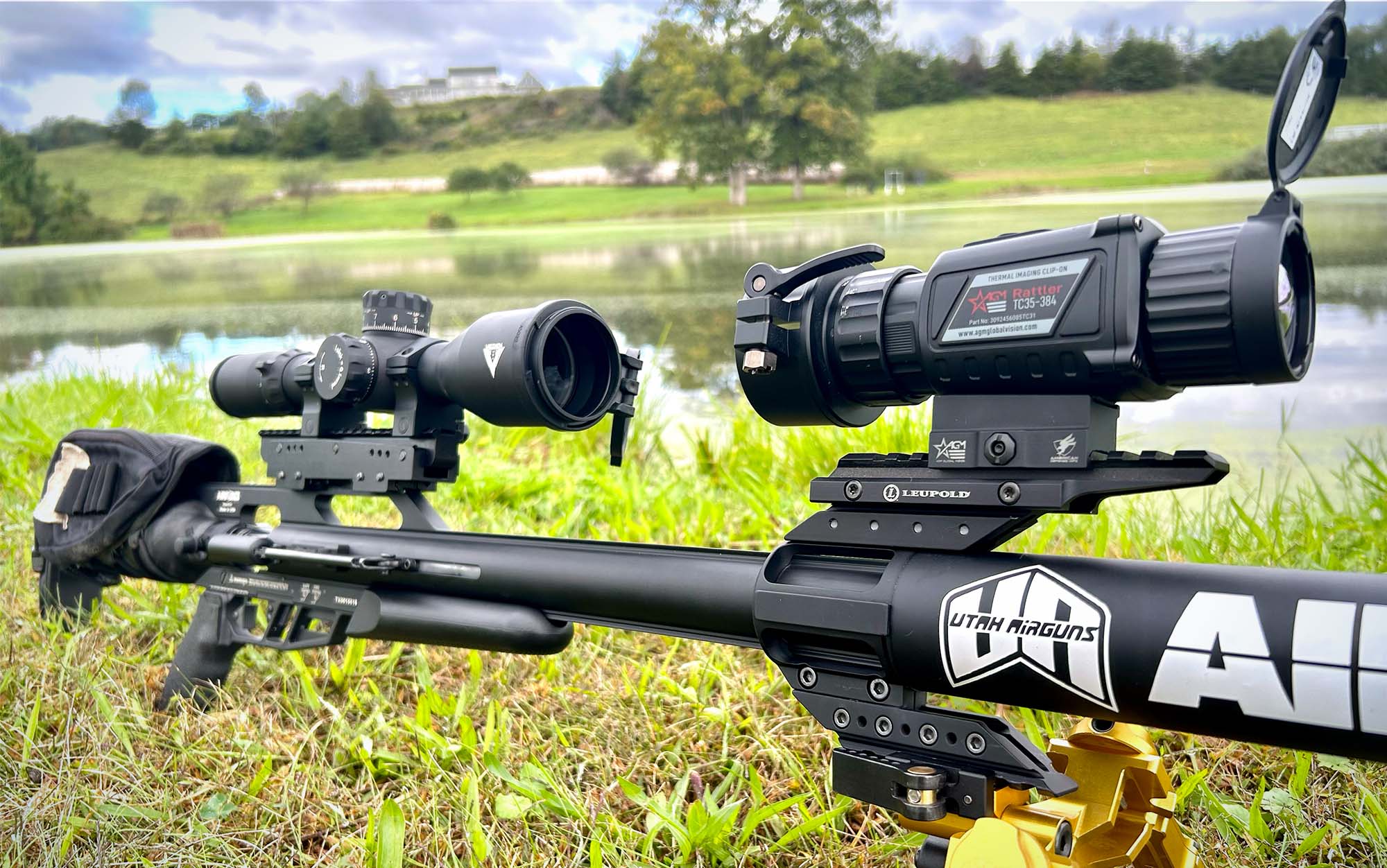
The Rattler has external battery capability. This is a huge plus if you want to hunt for more than 4 hours or hunt in extreme weather. Freezing temperatures will kill a normal CR123 battery quickly, but an external battery pack rated for 20 hours will let you hunt without worrying about battery life. External batteries are also easy to wrap a hand warmer around, extending operating time greatly.
The rattler records video and takes photos. It boasts 16 GB of onboard storage, which is plenty to get you through even the most active hunts. Be aware that there is no microphone, so the recordings have no sound. To get around this, I purchased a cheap audio recorder the size of a pack of gum for when I want the audio. Unless you are a YouTuber like me, you probably won’t care much about the audio, but it is worth noting. My only real complaint with the video function is that it requires a long press of 3 to 4 seconds to start. That can feel like a long time when a coyote is passing through.

One thing to remember when using this unit or any other clip-on is that less magnification on your day scope is better. Low magnification lets you see more of the OLED display. More magnification is helpful for longer shots but restricts your field of view. For this reason, I like a second-focal plane scope with low magnification and illuminated reticle. I find the sweet spot to be around 5x magnification when using clip-ons.
My Rattler is incredibly repeatable when taking it on and off of the rifle, holding within 1 inch of zero at 100 yards. I have also found that when attaching it to the scope bell, it can be used on scopes of the same brand and model without re-zeroing the thermal unit. That’s why I own multiple rifles with the same brand and model scope on them. This allows me to choose which rifle is best for the task at hand, whether it be an AR-10, bolt gun, or airgun all without touching the clip-on’s settings.
At about $2700, this optic packs in a ton of features and is a great option for owning the night.—Keith Gibson
Read Next: Best Night Vision Scopes
How to Choose the Best Thermal Monocular

After you’ve talked yourself into needing a thermal monocular, your next questions should be about capability and cost.
Capability
Do you need to share videos with your buddies? Then make sure to pick a viewer with easy image sharing, and the best of the bunch have mobile apps that enable sharing. Will you be using it in sub-zero conditions? If so, consider battery run time. And you should critically assess your tech skills, because most of these units require a fair amount of digital savvy to get up and running, and then to get the most out of their capabilities.
All these thermal units have different viewing modes. The industry standard has become some variation of these palettes: white hot, black hot, rainbow, and red hot. And most devices have some sort of on-board recording feature, but there’s a wide range of capabilities, including built-in Wi-Fi and Bluetooth that allow users to share images.
As you’re looking over the field, also take note of the imaging capabilities of various devices. Some have extremely rich resolution, thanks to large objective lenses that gather more detail. Others deliver sharp renditions of the image because of high-resolution screens, and still others use more or fewer pixels to influence the image. The best have high scores in each of these three categories; others might compensate for poor resolution with a sharp screen.
Be aware of the limitations of the monoculars I’ve reviwed. As a class, they are designed to identify thermal variations (the night-vision and infrared devices amplify ambient light). They’re not designed as targeting aids or riflescopes – we’ll cover that category of thermals in another post. This is an important consideration, because if you’re looking for a thermal to get you started in nighttime hog or predator hunting, then you’re probably better off investing in a thermal scope or clip on.
Cost
Next, how much are you willing to spend on a thermal viewer? Products in this roundup range in price from about $400 up to well over $3,500. Because entry-level products generally tether to your phone, their versatility is limited. But the higher-end thermal viewers offer so much resolution and imaging talent that unless you’re using the devices frequently, you may be paying for more capability than you need.
The thermal or night-vision optic that’s right for you will depend on how you’ll use it. If you simply want to know what goes bump in the night, a simple hand-held thermal is a good choice for detection, and is by far the most cost-effective category of this class of optics. Most have on-board recording of both video and still images, various display modes, and are housed in compact, ergonomic bodies. Expect to pay anywhere from $650 to $2,500 for these units.
The least expensive units are those that connect to smart phones. Because of their diminutive size and modest on-board controls, they have limited resolution, but they can cost anywhere from $400 to about $800.
Of course if you want to clearly identify objects at long distances, record HD video, and range targets, expect to pay well over $3,000. If you also want a monocular that works as a clip-on weapon sight, with the same capability, you can expect to pay $6,000 to $17,000.
Why Are Thermal Monoculars so Expensive?
In terms of cost, you’re mainly paying for two attributes. For thermal units, the first is the heat-sensing lens. It’s made of a special crystal called germanium that, when shaped into a lens, blocks extraneous wavelengths and boosts temperature differentials. And you’re paying for image processing speed and resolution. An expensive thermal allows you to clearly identify animals and an inexpensive one will show you animal-shaped blobs. It’s like the difference between the first cellphone cameras and the latest iPhone model.
Final Thoughts on the Best Thermal Monoculars
A thermal monocular, especially one with a laser rangefinder, adds a lot of capability to night hunting. You can safely scan the surrounding area to look for game, identify it, and get a range before you ever pick up your rifle. The new helmet mounted options mean you can navigate with thermal and night vision to get the best of both worlds. The hardest part is choosing the right product and price point for your needs. As of right now, there aren’t many bargains when it comes to high-end thermals. You get what you pay for, but that doesn’t mean lower-priced options don’t have their place. Even a cheap thermal is excellent for detecting animals within 100 yards and if that’s all you need, you can save a few grand.
- Editor’s Choice: Pulsar Telos LRF XL50
- Innovation Award: Armasight Sidekick 640
- Great Buy: Pulsar Axion 2 XQ35 Pro LRF
- Best Thermal/Night-Vision Hybrid: Pulsar Merger Duo NXP50
- Best European-Made Monocular: Liemke Keiler 25.1
- Newcomer Award: Athlon Cronus ATS 35ML-400
- Best Thermal Binocular: X-Vision Beyond 300
- Best Entry-Level: X-Vision Infinity TM105
